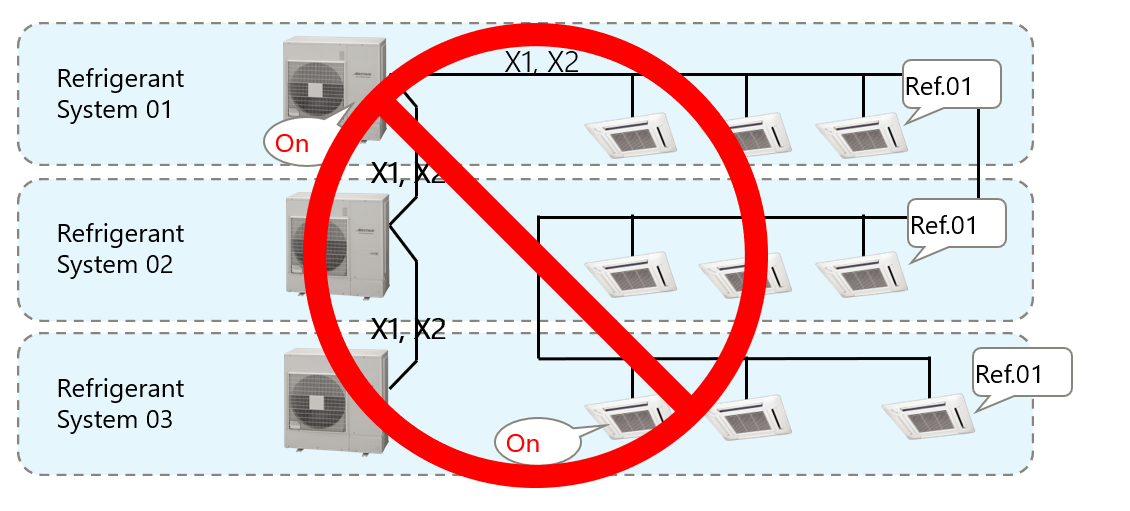1. Overview
Automatic addressing is a factory-supported process that assigns communication addresses automatically to indoor units (IUs), RB units, and signal amplifiers within a VRF system.
It simplifies commissioning — however, correct wiring, addressing sequence, and preparation are critical to prevent cross-communication or addressing failures.
2. Factory Default Address Configuration
All components must remain in their default (factory) state before initiating automatic addressing:
| Component | Factory Default | Notes |
|---|---|---|
| Refrigerant Address (REF AD) | 00 | Must be set manually on outdoor unit before starting auto address |
| Indoor Unit Address (IU AD) | 00 | Do not modify before auto addressing |
| RB Unit Address (RB AD) | 00 | Leave as default |
| Signal Amplifier Address | A1 | Default setting from factory |
⚠️ Automatic Addressing cannot be performed if any unit has already been manually addressed.
3. Correct Wiring Method Before Auto Addressing
Incorrect Wiring (Serial Configuration) – DO NOT USE
When multiple systems are daisy-chained (serial-wired) across the same transmission line:
All systems receive identical refrigerant addresses.
The first outdoor unit in the series may activate even when another system operates.
This results in cross-operation and address duplication.
? Avoid connecting multiple refrigerant systems in series on the same communication line.


Correct Wiring (Parallel Configuration) – REQUIRED
Each refrigerant system must be wired independently and connected in parallel from the transmission line.
| Configuration | Description |
|---|---|
| Parallel wiring ensures each refrigerant circuit is recognized individually. | |
| Only the system powered ON during addressing will receive address assignments. | |
| Prevents shared communication noise and duplicate addressing. |
✅ Always isolate systems during auto addressing by powering on one refrigerant circuit at a time.
4. Signal Amplifier Precautions
In systems with signal amplifiers, addressing must be performed in the following sequence:
Auto Addressing Order:
Signal Amplifiers – (1st Step)
Assign addresses A1–A8 manually before initiating auto addressing.
Without this step, subsequent unit addresses (IU/RB) will fail to register.
Indoor Units (IUs) – (2nd Step)
Once the signal amplifier is addressed, perform auto addressing for indoor units connected downstream.
RB Units – (3rd Step)
After indoor units are successfully addressed, auto address each RB unit in sequence.
⚠️ If signal amplifier addresses are not set first, indoor and RB units will not be assigned addresses.

5. Recommended Auto Addressing Sequence
| Step | Component | Description |
|---|---|---|
| 1st | Signal Amplifier | Assign or verify amplifier addresses (A1–A8). |
| 2nd | Indoor Units | Perform auto address procedure; each IU receives a unique ID. |
| 3rd | RB Units | Complete auto address after indoor addressing. |
? Tip: Always confirm the communication path before initiating the next step.
If a failure occurs, reset addresses and re-run the sequence.


6. Procedure to Initiate Auto Addressing
Verify Wiring:
Ensure transmission cables are securely connected in a parallel layout (X1/X2 or Z1/Z2 terminals).Power ON the system.
Select the Correct System:
Only energize one refrigerant system during auto addressing to avoid interference.Initiate Auto Addressing from the outdoor unit PCB or service tool.
Wait for Completion:
The process typically takes several minutes.
Confirm via display codes or commissioning software that all devices are detected.
Power Cycle:
Once complete, turn the system OFF and then back ON to save all assigned addresses.
7. Common Auto Addressing Issues and Solutions
| Issue | Possible Cause | Corrective Action |
|---|---|---|
| Indoor units not recognized | Signal amplifier not addressed first | Address signal amplifiers manually before reattempting |
| Duplicate addresses | Multiple systems powered during addressing | Power ON one system at a time |
| RB unit not detected | Incorrect wiring or missing communication | Verify polarity and connection integrity on transmission lines |
| Communication error after addressing | Serial wiring detected | Rewire to parallel configuration |
8. Key Technical Notes
The outdoor unit refrigerant address (REF AD) must be set manually before initiating automatic addressing.
Once any unit has been manually addressed, auto addressing becomes disabled for that device.
For multi-system networks, always verify address isolation before powering additional systems.
Do not use address ranges 64–99 for indoor or RB units — these are invalid and will not communicate.
9. Summary Checklist Before Auto Addressing
✅ Confirm all units are factory default.
✅ Outdoor unit REF AD manually set.
✅ Wiring layout is parallel (not serial).
✅ Signal amplifiers are addressed manually first.
✅ Only one refrigerant circuit is powered on during addressing.
✅ Sequence followed: Signal Amplifier → Indoor Unit → RB Unit.
